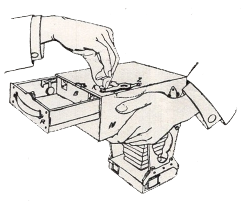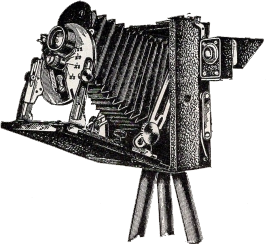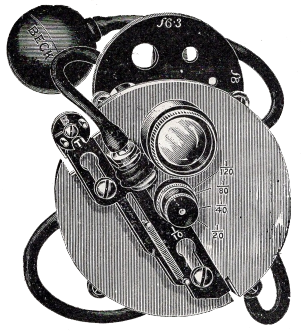|
Beck R J Folding Frena N° 8 |
Manufactured or assembled in United Kingdom from (Circa) 1901 to (After) 1901.
Inventory number: 13195
See the complete technical specifications
Chronology of cameras Beck R J
Beck R.J. offered unconventional technical solutions by combining elements that are not typically used simultaneously. The Folding Frena No. 6 combines a bellows camera with a 40-plate loading back. In the case of the Folding Frena No. 8, Beck hybridizes a loading back and a quarter-plate format bellows.
Several pages of the 1901 Beck RJ catalog (c.) are dedicated to presenting this model.
 The Folding Frena No. 8 is, to the best of our knowledge, the perfection of the Frena system applied to photography. It has, in a minimal space, all the adjustments provided to any camera, whether handheld or on a tripod. It features a perfect anastigmatic lens, with exceptional advantages required for the full use of special settings that make a camera absolutely complete for all kinds of working conditions. Moreover, it is arranged in such a way that these settings do not need to be used by those who prefer the simplest form of photography. In this case (as explained in detail in the instruction manual accompanying each camera), using the Folding Frena is almost as straightforward as using any camera on the market. Forty sheet films, 'Like a deck of cards,' or glass plates can be used. Long and short focal length lenses; tilting back, front movement in both directions; Time or instantaneous exposures up to 1/120.
The Folding Frena No. 8 is, to the best of our knowledge, the perfection of the Frena system applied to photography. It has, in a minimal space, all the adjustments provided to any camera, whether handheld or on a tripod. It features a perfect anastigmatic lens, with exceptional advantages required for the full use of special settings that make a camera absolutely complete for all kinds of working conditions. Moreover, it is arranged in such a way that these settings do not need to be used by those who prefer the simplest form of photography. In this case (as explained in detail in the instruction manual accompanying each camera), using the Folding Frena is almost as straightforward as using any camera on the market. Forty sheet films, 'Like a deck of cards,' or glass plates can be used. Long and short focal length lenses; tilting back, front movement in both directions; Time or instantaneous exposures up to 1/120.
 The film holder. This part includes a sliding box containing any number of Frena films from 1 to 40 under the pressure of a spring, with the front one always at the focal point of the lens. To change the film, this sliding box is partially removed, as shown in Figure 3, while the camera is held with the lens end facing downward. By turning handle A, the first film is automatically deposited in the receiving chamber, where exposed films are placed one by one in the order they were taken.
The film holder. This part includes a sliding box containing any number of Frena films from 1 to 40 under the pressure of a spring, with the front one always at the focal point of the lens. To change the film, this sliding box is partially removed, as shown in Figure 3, while the camera is held with the lens end facing downward. By turning handle A, the first film is automatically deposited in the receiving chamber, where exposed films are placed one by one in the order they were taken.
 Figure 4 provides an enlarged view of the handle used to change the film, showing the indicator at N, recording the number of exposed films. The principle of the Frena system is the same in all types and models of Frena cameras. A pack of Frena films, as supplied by the manufacturers, is unpacked in non-actinic light and placed directly into the camera in one pack without any handling. They are then, one by one, placed in the receiving chamber as exposed and can be removed at any time for development, or can be left until the entire pack is used. The entire process of removing exposed films and reloading, including packing and unpacking, can be easily accomplished in three minutes.
Figure 4 provides an enlarged view of the handle used to change the film, showing the indicator at N, recording the number of exposed films. The principle of the Frena system is the same in all types and models of Frena cameras. A pack of Frena films, as supplied by the manufacturers, is unpacked in non-actinic light and placed directly into the camera in one pack without any handling. They are then, one by one, placed in the receiving chamber as exposed and can be removed at any time for development, or can be left until the entire pack is used. The entire process of removing exposed films and reloading, including packing and unpacking, can be easily accomplished in three minutes.
Mounting glass plates. Thanks to the new arrangement of the film holder, the Folding Frena is constructed so that the lens, shutter, and camera can be detached from the magazine and film-changing part. The camera part, including the lens and shutter, represents about a quarter of the whole, as seen in Fig. 2. With the addition of a ground glass accessory and a double plate holder, it can be used as an ordinary plate camera. We have set up a special machine factory, not only for the production of the camera and film holder but also for the manufacture of a cheap and reliable double plate holder.

Figure 5 shows the Folding Frena No. 8 with the flap open and the lens and shutter in the operating position. A focusing lever is provided. A scale (in feet) for lens adjustment is specially calibrated for each camera so that complete trust can be placed in its accuracy. A new device has been invented so that focusing can be done by the direct method, even when the film holder is attached to the camera. If the drawer of the rear part is open, a ground glass, which is provided, can be inserted into a slide. It is then in the exact position that the film usually occupies, and by looking through the loupe at the other end, the center of the image can be focused directly.
 A tilting back is provided that can be used with great ease. The supports that hold the flap are designed so that it ordinarily goes into a horizontal position, but for the use of the rear tilt, they can be tightened at any angle as needed with two countersunk heads. Fig. 5 shows the camera with the rear tilt and front shift in use.
A tilting back is provided that can be used with great ease. The supports that hold the flap are designed so that it ordinarily goes into a horizontal position, but for the use of the rear tilt, they can be tightened at any angle as needed with two countersunk heads. Fig. 5 shows the camera with the rear tilt and front shift in use.
 Figure 7 shows the Folding Frena with the double extension in use, allowing the use of the half-combination of the Beck-Steinheil Orthostigmat lens by simply unscrewing the front lens group. Thus, a long-focal-length lens can be obtained that will give an image approximately twice the size of that given by the normal lens. The front shifts 1 inch in the vertical position and 4 inches in the horizontal position. The camera thus has all the adjustments of a view camera, arranged so as not to complicate the use of the instrument and not to need to be used unless desired.
Figure 7 shows the Folding Frena with the double extension in use, allowing the use of the half-combination of the Beck-Steinheil Orthostigmat lens by simply unscrewing the front lens group. Thus, a long-focal-length lens can be obtained that will give an image approximately twice the size of that given by the normal lens. The front shifts 1 inch in the vertical position and 4 inches in the horizontal position. The camera thus has all the adjustments of a view camera, arranged so as not to complicate the use of the instrument and not to need to be used unless desired.
 The shutter. This shutter is our new patent Wafer. It is made in an aluminum housing with a thin rotating steel plate for exposure. It is on the same principle as our famous Frena shutter, in which the variation of speeds is obtained by changing the size of the aperture that passes over the lens. There are no brakes or other devices, and therefore the speeds can always be considered practically accurate. The following instantaneous speeds can be obtained: 1/10, 1/20, 1/40, 1/80, and 1/120, and exposures can be made in two ways. To give a short exposure, the disc on the plate must be set to the letter B (Bulb). In this case, squeezing the pneumatic bulb opens the lens, which remains open only as long as the bulb is pressed but closes as soon as the pressure on the bulb is released. Thus, exposures of one to 3 or 4 seconds can be conveniently made. When the disc on the trigger is facing the letter T, pressing the bulb opens the lens, which remains open for some time, and to close it, the bulb must be pressed a second time. The pneumatic trigger, which is held in a spring socket, can be completely removed, and exposure can be made with the finger by pressing the trigger.
The shutter. This shutter is our new patent Wafer. It is made in an aluminum housing with a thin rotating steel plate for exposure. It is on the same principle as our famous Frena shutter, in which the variation of speeds is obtained by changing the size of the aperture that passes over the lens. There are no brakes or other devices, and therefore the speeds can always be considered practically accurate. The following instantaneous speeds can be obtained: 1/10, 1/20, 1/40, 1/80, and 1/120, and exposures can be made in two ways. To give a short exposure, the disc on the plate must be set to the letter B (Bulb). In this case, squeezing the pneumatic bulb opens the lens, which remains open only as long as the bulb is pressed but closes as soon as the pressure on the bulb is released. Thus, exposures of one to 3 or 4 seconds can be conveniently made. When the disc on the trigger is facing the letter T, pressing the bulb opens the lens, which remains open for some time, and to close it, the bulb must be pressed a second time. The pneumatic trigger, which is held in a spring socket, can be completely removed, and exposure can be made with the finger by pressing the trigger.
The viewfinder, shown in Figs. 1, 5, 7, is designed on the principle of our Cornex viewfinder. The amount of view included in the image is accurately represented in the viewfinder and does not vary depending on the angle from which the observer looks at it. It is as reliable as the old ground glass viewfinder and as bright as any of the so-called bright viewfinders. It folds into the camera when not in use, but when attached to the camera, it can be used for horizontal or vertical images by simply rotating the rear part without moving its position on the camera.
The lens. The Folding Frena No. 8 carries one of the new Beck-Steinheil Orthostigmat lenses with an aperture of f/6.3. Even with this very large aperture, the edges of the plate are as sharp as the center, and vertical shifting can be used to its full extent, namely: 1 inch, with barely any noticeable loss of definition. The front half of the lens can be removed, and the rear half used alone as a lens of double focal length and a quarter of the speed.
__________

In 1854, two brothers, Richard and Joseph Beck, renamed their London-based optics and microscope company to R & J Beck Ltd after the withdrawal of their third partner, James Smith. The production of cameras began in 1880, and it was in 1892 that the Frena models with their unique system of a notched-edge roll film magazine were introduced.
Interesting links or bibliography :
Add a link or element of bibliography, a picture taken with this camera, a picture of box or an ads about this camera
Your photos taken with the same camera:
Cameras from Ebay France (Beck R J) (Uploaded each 3 hours)








